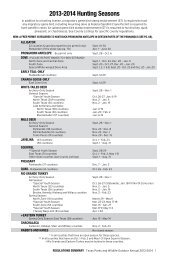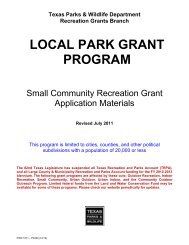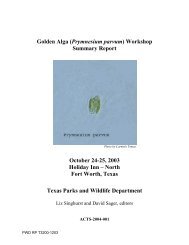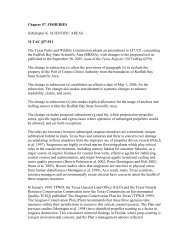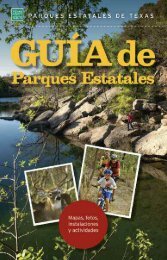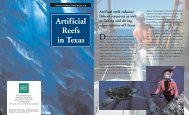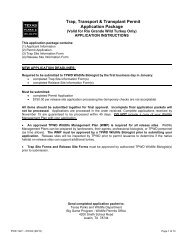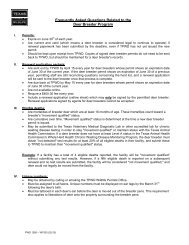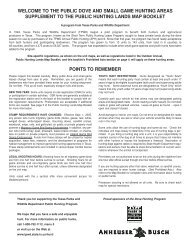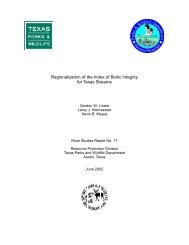1-1 Appendix 1 Responses to survey questions administered to ...
1-1 Appendix 1 Responses to survey questions administered to ...
1-1 Appendix 1 Responses to survey questions administered to ...
Create successful ePaper yourself
Turn your PDF publications into a flip-book with our unique Google optimized e-Paper software.
in our sampling approaches and <strong>to</strong> find ways <strong>to</strong> free-up staff time <strong>to</strong> conduct more<br />
intensive sampling in critically important areas/fisheries.<br />
• Expertise is available, but organizational structure, funding, and current priorities<br />
do not allow maximum efficiency relative <strong>to</strong> habitat and invasive species issues.<br />
• We have some staff and organization but I don’t believe we have yet developed a<br />
cohesive plan <strong>to</strong> address this issue from both a resource and recreational user<br />
perspective.<br />
• More staff will be needed <strong>to</strong> collect the data needed state wide.<br />
• I believe the agency is positioned well, in terms of expertise and structure, <strong>to</strong><br />
address both water allocation and golden alga issues. Both issues are huge in<br />
magnitude and will require cooperative efforts with other agencies, academia, and<br />
various outside entities. However, funding for additional staff,<br />
facilities/equipment, and research are needed <strong>to</strong> adequately address the problems.<br />
• TPWD Inland Fisheries is largely focused on managing sportfish. Integration of<br />
the former Resource Protection Division may help change the focus <strong>to</strong> larger<br />
habitat and environmental issues, but this would require a major paradigm shift.<br />
INLAND NON-ADMINISTRATIVE--QUESTION 1<br />
RESPONDENTS: 35<br />
What is the greatest strength/impediment in the agency’s ability <strong>to</strong> apply scientific<br />
information <strong>to</strong> resource management?<br />
• Strength – Staff expertise. The staff of the TPWD is knowledgeable and capable<br />
of collecting and applying the scientific information needed <strong>to</strong> manage the natural<br />
resources of Texas.<br />
• The greatest strength is the caliber of employees, generally. Our personnel are all<br />
trained scientists and apply this discipline <strong>to</strong> the management of fisheries<br />
resources. Very little anecdotal information is applied here.<br />
• The greatest strength is the quality of the staff, particularly the field staff who<br />
make the day <strong>to</strong> day decisions regarding resource management activities. We have<br />
some of the most highly qualified people in the country in the agency.<br />
• Strength – education of staff and dedication of staff <strong>to</strong> provide the best fisheries<br />
possible.<br />
• Strength – Integrity and professionalism of IF staff.<br />
• Strengths – Up <strong>to</strong> date equipment, training, and reputation with constituents.<br />
• Strength=Excellent research, management, hatchery, and aquatic staff.<br />
• First, Inland Fisheries is blessed with a very dedicated and motivated staff. A<br />
diverse “melting-pot” of talented scientists who, with administrative<br />
encouragement and support, have his<strong>to</strong>rically been given the latitude <strong>to</strong> utilize<br />
innovative approaches in managing fisheries resources. The availability of good<br />
scientifically sound data, interpretation and use of that data when implementing<br />
applied management programs, have translated in<strong>to</strong> many successes and<br />
achievements in resource management. Constituents are for the most-part<br />
satisfied with our fisheries programs and remain confident in the staff.<br />
2-23



